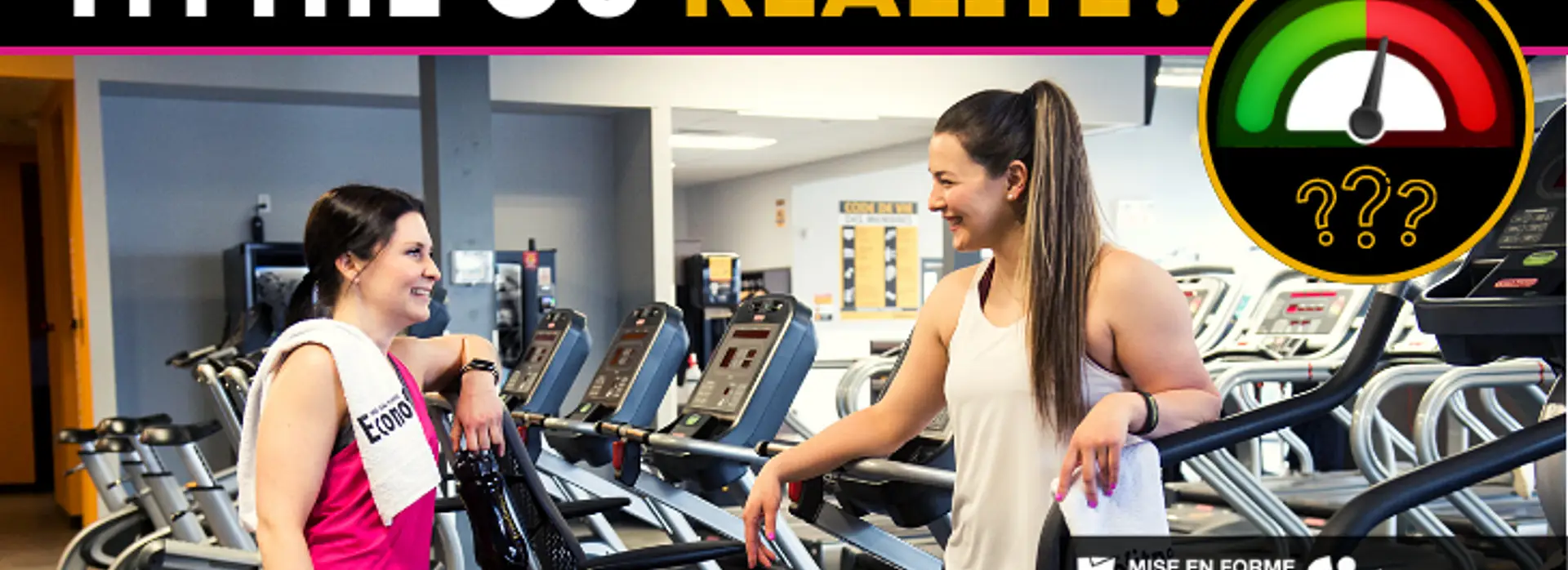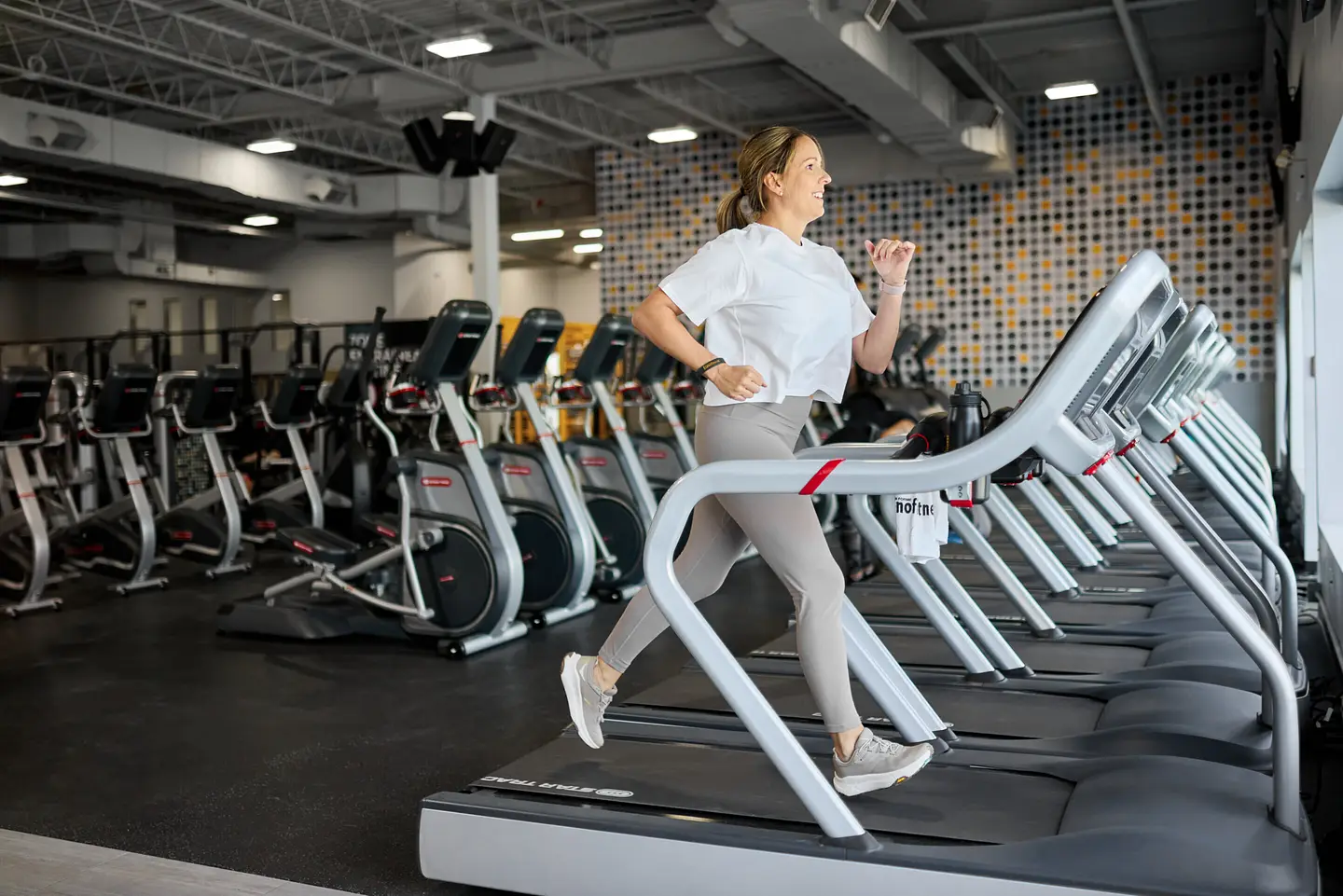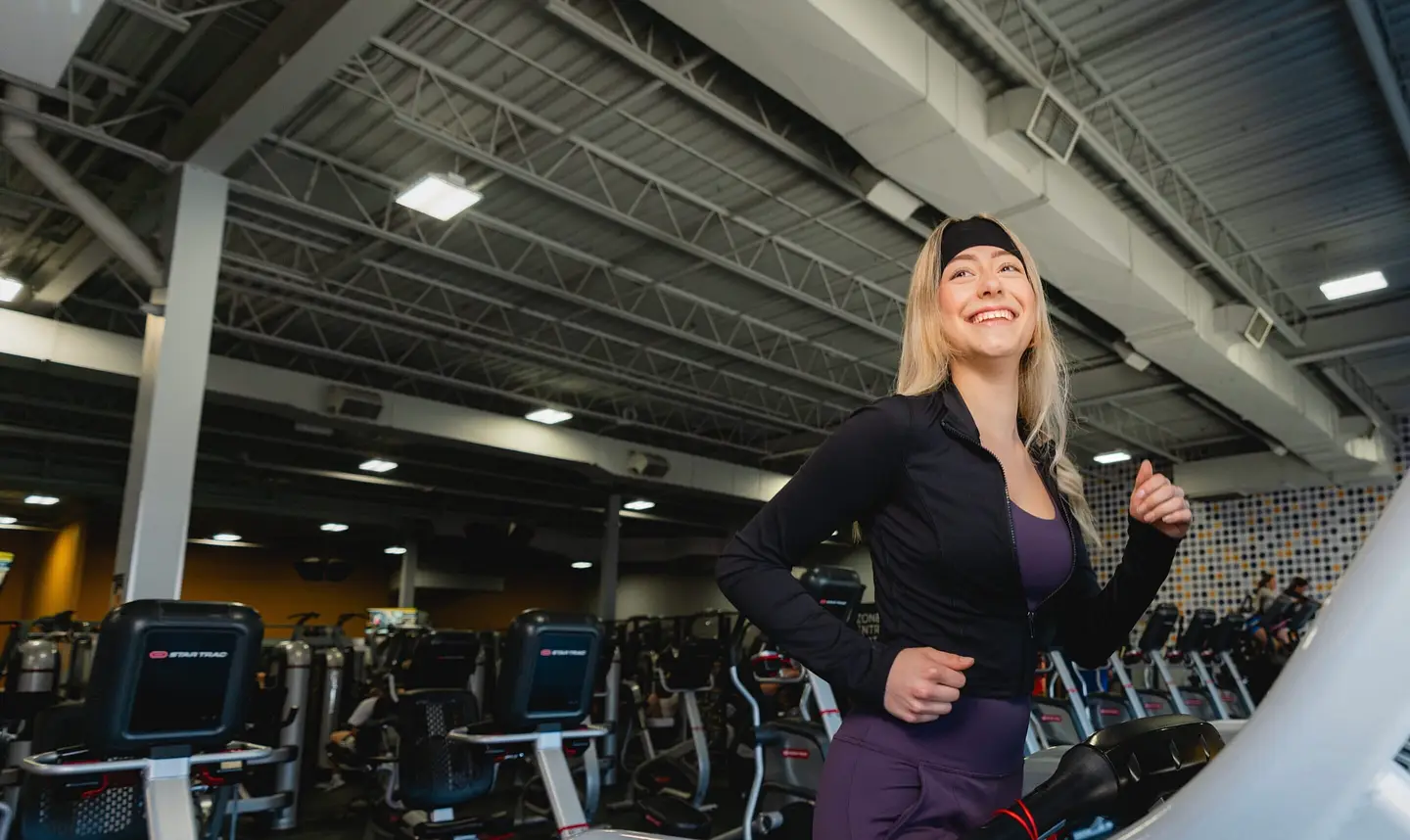10 myths and facts about fitness!

Presented by:

❓ WORKING OUT ON AN EMPTY STOMACH IS GOOD

Nowadays, we just have to type a word in a search engine (thanks Google) to have a variety of information at our fingertips. And social media provides us with another source of information, whether we like it or not. This means it's not always easy to separate truth from myth, especially when it comes to exercise and fitness.
In this article, passionate kinesiologists from the Éconofitness fitness team address 10 myths and facts related to the gym in order to give you accurate and relevant information.
In this article, passionate kinesiologists from the Éconofitness fitness team address 10 myths and facts related to the gym in order to give you accurate and relevant information.
❓ SWEAT ELIMINATES TOXINS
👎 MYTH! Many types of exercise promote the virtues of excessive sweating to eliminate toxins. Sorry to disappoint you, if you believed this myth, but it's time to set the record straight about sweating. Sweat is composed of approximately 95% water and 5% minerals and does not contain any toxins.
Only the liver and kidneys are able to eliminate toxins from your body. Physical activity combined with a balanced diet will ensure that your organs function properly. So, focus on a healthy and active lifestyle so that your toxins will be eliminated naturally.
Only the liver and kidneys are able to eliminate toxins from your body. Physical activity combined with a balanced diet will ensure that your organs function properly. So, focus on a healthy and active lifestyle so that your toxins will be eliminated naturally.
❓ THE MORE YOU SWEAT, THE MORE FAT YOU BURN
👎 MYTH! As you read above, sweat contains about 95% water and 5% minerals. So, there is no fat shed through the pores of your skin. Some people believe there’s a direct link between sweating and weight loss, which isn’t true. This notion is probably due to the fact that the more intensely you work out, the more you sweat in general. However, it’s common to see two people doing the same workout at the same intensity but not sweating to the same degree.
Men tend to sweat more than women, but some women can also sweat a lot. In reality, sweating is a system for regulating body temperature. That's why you sweat profusely during a summer heat wave even when you're just sitting in a chair. Although you’re sweating, you’re obviously not burning any fat!
Men tend to sweat more than women, but some women can also sweat a lot. In reality, sweating is a system for regulating body temperature. That's why you sweat profusely during a summer heat wave even when you're just sitting in a chair. Although you’re sweating, you’re obviously not burning any fat!
❓ TAKING PROTEIN SUPPLEMENTS IS GOOD FOR EVERYONE WHO WORKS OUT
👎 MYTH! As people begin to include exercise in their schedule, many also want to add protein supplements to their dietary routine. However, before you buy those gigantic jars, know that protein is mainly useful and necessary for rebuilding muscle. Before consuming supplements, it’s essential to ask yourself the following two questions:
1- What is your exercise goal?
If the answer is overall fitness or increasing your cardiovascular endurance, the protein already contained in a balanced diet will be sufficient for your recovery. You will only need supplements if you want to gain muscle mass. In this case, the type of workout needed to achieve this will require greater amounts of protein for recovery.
2- Are you getting enough protein in your diet?
For those who exercise moderately to achieve overall fitness, the recommendation is to consume 1.2 to 1.5 grams of protein per kilogram of body weight daily. For those working out to gain muscle mass, we suggest consuming between 1.8 and 2 grams of protein per kilogram of body weight. So, for example, for a 60-kilogram person who wants to get in shape, 75 grams of protein per day will be enough. If that same person wants to gain muscle mass, then it’s recommended that they consume 110 grams of protein.
After reading the above information, if you’re interested in taking protein supplements, take a look at our exclusive member discounts to save on these products!
1- What is your exercise goal?
If the answer is overall fitness or increasing your cardiovascular endurance, the protein already contained in a balanced diet will be sufficient for your recovery. You will only need supplements if you want to gain muscle mass. In this case, the type of workout needed to achieve this will require greater amounts of protein for recovery.
2- Are you getting enough protein in your diet?
For those who exercise moderately to achieve overall fitness, the recommendation is to consume 1.2 to 1.5 grams of protein per kilogram of body weight daily. For those working out to gain muscle mass, we suggest consuming between 1.8 and 2 grams of protein per kilogram of body weight. So, for example, for a 60-kilogram person who wants to get in shape, 75 grams of protein per day will be enough. If that same person wants to gain muscle mass, then it’s recommended that they consume 110 grams of protein.
After reading the above information, if you’re interested in taking protein supplements, take a look at our exclusive member discounts to save on these products!
❓ IT’S IMPORTANT FOR WOMEN TO INCLUDE STRENGTH TRAINING IN THEIR WORKOUT ROUTINE
👍 FACT! No matter what their exercise goal is, it’s essential for women to include strength training as part of their workout routine. Let’s clear up one concern women have about strength training: it’s impossible for women to develop muscles that look like The Rock’s. In the event that gaining significant muscle mass is a woman's main objective, she would need to follow a specific training program combined with a very strict diet plan.
As mentioned in the article 6 reasons women should do strength training, even for basic fitness purposes, strength training has many benefits. These include improved muscle tone, greater muscle endurance and strength, better posture, greater ease performing everyday movements, greater range of motion, decreased risk of injury, better bone health and more!
As mentioned in the article 6 reasons women should do strength training, even for basic fitness purposes, strength training has many benefits. These include improved muscle tone, greater muscle endurance and strength, better posture, greater ease performing everyday movements, greater range of motion, decreased risk of injury, better bone health and more!
❓ WEIGHT LOSS IS A REALISTIC AND ATTAINABLE GOAL
👎 MYTH! As you can read in "Breaking down weight loss, building your self-esteem" guide, having a goal of achieving a healthy lifestyle is much more realistic than focusing solely on weight loss, especially for maintaining good habits over the longer term. Exercise combined with a balanced diet will provide an array of benefits to your overall health, such as improved cardiovascular fitness, improved range of motion, improved endurance, decreased risk for a wide range of diseases and more. All of these benefits will have a positive impact on many aspects of your life, even if no weight loss is experienced.
To achieve weight loss through exercise alone, you would have to expend a huge number of calories. Because a typical workout burns about 300 calories per session, and because losing 1lb of fat requires you to burn 3500 calories, it would take more than 10 workouts per week to achieve weight loss. Not very realistic, admit it!
And if the workout sessions are combined with a diet, is the strategy more successful? Well, no! Several studies show that most of the time, 100% or more of the weight lost after going on a diet is regained within 5 years.
So, as this article explains so well, remember that it’s best to do away with the concept that weight loss is the ultimate goal for achieving happiness. Rather, weight loss should be a consequence of a distinct goal, such as increasing your energy level, getting stronger or developing a healthy relationship with food. The best advice we can give you is to have fun exercising! The more fun you have, the more you'll want to repeat the experience and that's how you'll be able to make exercise a permanent part of your life!
To achieve weight loss through exercise alone, you would have to expend a huge number of calories. Because a typical workout burns about 300 calories per session, and because losing 1lb of fat requires you to burn 3500 calories, it would take more than 10 workouts per week to achieve weight loss. Not very realistic, admit it!
And if the workout sessions are combined with a diet, is the strategy more successful? Well, no! Several studies show that most of the time, 100% or more of the weight lost after going on a diet is regained within 5 years.
So, as this article explains so well, remember that it’s best to do away with the concept that weight loss is the ultimate goal for achieving happiness. Rather, weight loss should be a consequence of a distinct goal, such as increasing your energy level, getting stronger or developing a healthy relationship with food. The best advice we can give you is to have fun exercising! The more fun you have, the more you'll want to repeat the experience and that's how you'll be able to make exercise a permanent part of your life!
❓ SINCE I'M WORKING OUT, I CAN EAT MORE
👎 MYTH! First, the main question to ask yourself is: what is my exercise goal? For the majority of responses, your intake should not increase, it should be modified instead.
As explained in our "Breaking down weight loss, building your self-esteem" guide the goal is to listen to your body's signals and adapt to the changes. By making physical activity part of your daily routine, your hunger may be somewhat disrupted. It’s normal to feel a little hungrier at first as your body adapts. Eventually, your body will adapt to the changes. Above all, don't deprive yourself of food. It’s really important to listen to your body to avoid falling into a period of fatigue.
As explained above, if your exercise goal is to build muscle mass, you will definitely need to increase your protein intake. In this case, you will need to eat more. Nevertheless, your diet will have to be well controlled and, above all, you won’t be able to eat just anything if you want to reach your goal.
As explained in our "Breaking down weight loss, building your self-esteem" guide the goal is to listen to your body's signals and adapt to the changes. By making physical activity part of your daily routine, your hunger may be somewhat disrupted. It’s normal to feel a little hungrier at first as your body adapts. Eventually, your body will adapt to the changes. Above all, don't deprive yourself of food. It’s really important to listen to your body to avoid falling into a period of fatigue.
As explained above, if your exercise goal is to build muscle mass, you will definitely need to increase your protein intake. In this case, you will need to eat more. Nevertheless, your diet will have to be well controlled and, above all, you won’t be able to eat just anything if you want to reach your goal.
❓ WORKING OUT ON AN EMPTY STOMACH IS GOOD
👎 MYTH and 👍FACT! To date, there’s a lot of conflicting research, which makes it virtually impossible to get a clear answer on the subject. Working out on an empty stomach is often seen as a good method, especially for weight loss. But is it healthy? If you exercise at high intensity without eating, your body will not have the energy to generate that kind of intensity. In this case, you should work out at a moderate intensity.
If the morning is your only time to work out, we advise you hydrate and ingest liquid proteins, as they do not spend too much time in the stomach. However, don't go out of your way to do your workouts on an empty stomach thinking it's more beneficial. Instead, focus on a balanced diet and working out a few times a week to maintain a healthy and active lifestyle.
❓ STATIC STRETCHING BEFORE EXERCISE IS UNNECESSARY
If the morning is your only time to work out, we advise you hydrate and ingest liquid proteins, as they do not spend too much time in the stomach. However, don't go out of your way to do your workouts on an empty stomach thinking it's more beneficial. Instead, focus on a balanced diet and working out a few times a week to maintain a healthy and active lifestyle.
❓ STATIC STRETCHING BEFORE EXERCISE IS UNNECESSARY
👍 FACT! It’s true that static stretching before a workout has often been thought to reduce the risk of injury. However, according to several research studies, the opposite is true. Stretching before working out could even lead to injury. When we stretch, our muscle lengthens beyond its original resting length. By holding the stretch for several seconds, our muscle goes into a resting position, when the opposite effect is desired. We want to wake up our muscle, not put it to sleep!
Before a workout, our muscles must be ready to contract quickly and efficiently. Instead of doing static stretching, it’s better to activate your muscles using a lower intensity and starting with smaller movements. Examples include walking before running or lifting a lighter weight than what will be used during the workout.
Before a workout, our muscles must be ready to contract quickly and efficiently. Instead of doing static stretching, it’s better to activate your muscles using a lower intensity and starting with smaller movements. Examples include walking before running or lifting a lighter weight than what will be used during the workout.
❓ POST-WORKOUT STRETCHING REDUCES SORENESS
👎 MYTH! It’s still common to hear people say that it’s important to stretch after a workout to avoid being sore the next day. We apologize to those who thought they had found the miracle cure to avoiding soreness, but unfortunately there isn't one (unless you want to reduce the intensity of your workouts)! The explanation is relatively simple to understand: when we perform a movement we’re not used to or with higher intensity, our muscle experiences slight trauma and it creates micro-tears (don't worry, it's normal). The pain experienced 24 to 48 hours after exercise comes mainly from the repairing of these tears. In short, if your muscle fibre was slightly torn during the exercise and then you stretch it, you risk increasing the tear rather than preventing it. But no need to panic, the stretch would need to be very pronounced for this reaction to occur.
The main reason stretching is recommended after a workout is simply because our bodies are warm and, therefore, more pliable. Plus, you're already at the gym, so stretching at the end of your workout will make it even more complete and effective. While we tend to overlook this part of working out, remember that it’s important to work on flexibility to maintain overall fitness.
The main reason stretching is recommended after a workout is simply because our bodies are warm and, therefore, more pliable. Plus, you're already at the gym, so stretching at the end of your workout will make it even more complete and effective. While we tend to overlook this part of working out, remember that it’s important to work on flexibility to maintain overall fitness.
❓ IT’S IMPORTANT TO ELIMINATE LACTIC ACID FROM OUR MUSCLES TO EASE PAIN
👎 MYTH! How many times have you heard that it’s the accumulation of lactic acid in your muscles that causes pain? Or that it's important to shake out your limbs after exercise or stretch to release the acid from your muscles? In reality, it’s impossible for lactic acid to accumulate since it only remains in the muscle for a few seconds before separating into "lactate" and "H+ ion" (sorry for the scientific terms!). In fact, the "lactate" part of lactic acid is our friend! The more of it we create, the faster we’re able to produce energy. So instead of thinking of lactic acid as the villain of the story, tell yourself that the more you create, the more energy you’ll have to keep working out!
There are of course many other aspects of exercise that have yet to be demystified. We will gladly go over some of them together soon in another article. In the meantime, don't hesitate to check your sources when you’re unsure about anything you’ve heard or read. Just because you found it on the internet doesn't mean it’s necessarily true (unless it came from Éconofitness, obviously 😉). In addition, some answers may not be black or white and may require clearer and more elaborate explanations. One thing is certain, when it comes to working out, make sure to always have fun! Doing so will make you want to do it more often, and that's not a myth 😉.
There are of course many other aspects of exercise that have yet to be demystified. We will gladly go over some of them together soon in another article. In the meantime, don't hesitate to check your sources when you’re unsure about anything you’ve heard or read. Just because you found it on the internet doesn't mean it’s necessarily true (unless it came from Éconofitness, obviously 😉). In addition, some answers may not be black or white and may require clearer and more elaborate explanations. One thing is certain, when it comes to working out, make sure to always have fun! Doing so will make you want to do it more often, and that's not a myth 😉.
What we offer
More than
75 gyms
in Quebec

Most gyms
open
24/7
Starting at
$129.75
per year

Today is the day. Join now!
Éconofitness is THE gym you need to work out more and feel great! Over 75 gyms in Quebec, most of which are open 24/7, with memberships starting at $129.75/year, enough quality equipment for everyone and a friendly atmosphere. Work out at your own pace starting today!

